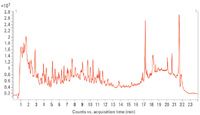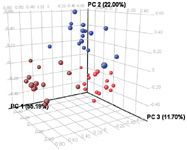A Prediction Model for Determining Wine Variety Using the Agilent LC/MS Q-TOF and Agilent
Wine is a beverage produced and consumed throughout the world and is a highly valued commodity. Its classification and authenticity can be very important.
This work was reported in L. Vaclavik, O. Lacina, J. Hajslova, J. Zweigenbaum, Analytica Chimica Acta 2011, 685, 45 (http://www.sciencedirect.com/science/article/B6TF4-1GHWXP-1/2/e70f1f1928475f12c9341d8b67e05310).
INTRODUCTION
Wine is a beverage produced and consumed throughout the world and is a highly valued commodity. Its classification and authenticity can be very important. The constituents of wine are complex and include compounds that impart taste, color, and other characteristics that determine the quality of the beverage. One component is the type of grape used and the question this study examines is whether there are specific compounds in wine that distinguish one grape from another. Using wines obtained from around the world, the power of accurate mass and high resolution is put to use by analyzing three varieties of wine: Pinot Noir, Merlot, and Cabernet Sauvignon. Using Agilent's Mass Profiler Professional software, the resulting single MS data containing over 26000 entities are statistically evaluated. Once filtered on differences, principle component analysis shows that the wine variety can be grouped by specific compounds found in the wine samples. With this knowledge, a model based on partial least squares differentiation is made and unknown wines can be classified. All this is done without knowing the identity of the marker compounds that can distinguish one grape from another.

Figure 1. Total Ion Chromatogram on wine sample injected directly shows the complexity of the data
Using the Agilent 6530 Accutate-Mass Q-TOF LC/MS, MS/MS can be performed on the ions shown to correlate specific grapes, and identification can be pursued with the excellent accurate mass measurements. It is noted that the identification of true unknowns, compounds not found in any database, is a difficult task. However, identification is not necessary for this type of determination and even the unidentified compounds can be used with their MS/MS signatures for routine classification. This study demonstrates the power of the Agilent LC/MS Q-TOF in combination with Mass Profiler Professional's multivariate statistical capabilities designed specifically for MS data processing.

Figure 2. Principal component analysis of filtered results shows that Merlot, Cabernet Savagnoun, and Pinot Noir wines can be distinguished by these marker compounds.
KEY BENEFITS
- Agilent 6500 Series Q-TOF LC/MS provides the sensitivity, mass accuracy and resolution needed to separate unique compounds recognizing a wine's variety.
- Mass Profiler Professional provides the needed multivariate statistics directly on accurate mass spectral data.
- Mass Profiler Professional provides powerful models for prediction analysis.
- Comprehensive workflow wizards guide the experimenter through statistical analysis of their data to obtain powerful correlations and visualization of the results.
- With Q-TOF MS/MS, the identity of marker compounds may be obtained.
Agilent shall not be liable for errors contained herein or for incidental or consequential damages in connection with the furnishing, performance, or use of this material. Information, descriptions, and specifications in this publication are subject to change without notice.
Analytical Challenges in Measuring Migration from Food Contact Materials
November 2nd 2015Food contact materials contain low molecular weight additives and processing aids which can migrate into foods leading to trace levels of contamination. Food safety is ensured through regulations, comprising compositional controls and migration limits, which present a significant analytical challenge to the food industry to ensure compliance and demonstrate due diligence. Of the various analytical approaches, LC-MS/MS has proved to be an essential tool in monitoring migration of target compounds into foods, and more sophisticated approaches such as LC-high resolution MS (Orbitrap) are being increasingly used for untargeted analysis to monitor non-intentionally added substances. This podcast will provide an overview to this area, illustrated with various applications showing current approaches being employed.
Extracting Estrogenic Hormones Using Rotating Disk and Modified Clays
April 14th 2025University of Caldas and University of Chile researchers extracted estrogenic hormones from wastewater samples using rotating disk sorption extraction. After extraction, the concentrated analytes were measured using liquid chromatography coupled with photodiode array detection (HPLC-PDA).

.png&w=3840&q=75)

.png&w=3840&q=75)



.png&w=3840&q=75)



.png&w=3840&q=75)



